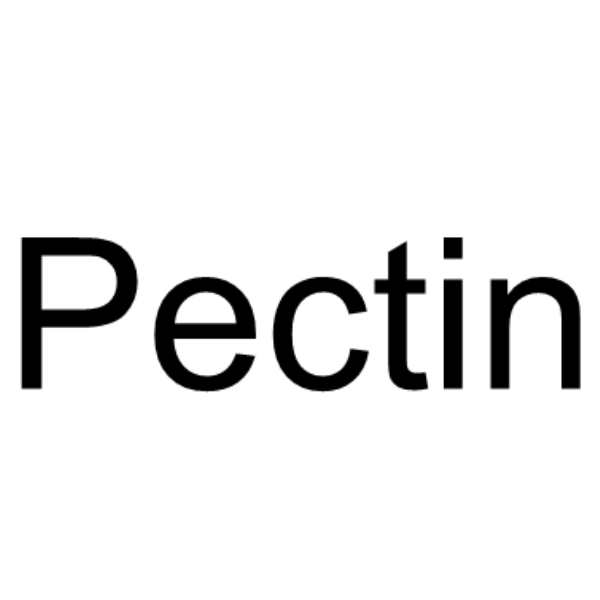Pectin

Pectin structure
|
Common Name | Pectin | ||
|---|---|---|---|---|
| CAS Number | 9000-69-5 | Molecular Weight | 150.130 | |
| Density | 1.5±0.1 g/cm3 | Boiling Point | 415.5±38.0 °C at 760 mmHg | |
| Molecular Formula | C5H10O5 | Melting Point | 6.1ºC | |
| MSDS | Chinese USA | Flash Point | 219.2±23.3 °C | |
Use of PectinPectin is a heteropolysaccharide, derived from the cell wall of higher plants. Pectin involves in the formation of nanoparticles as a delivery vehicle of drugs. Pectin is also an adsorbent, a broad-spectrum antimicrobial agent that binds to bacteria toxins and other irritants in the intestinal mucosa, relieves irritated mucosa[1][2][3]. |
| Name | pectin |
|---|---|
| Synonym | More Synonyms |
| Description | Pectin is a heteropolysaccharide, derived from the cell wall of higher plants. Pectin involves in the formation of nanoparticles as a delivery vehicle of drugs. Pectin is also an adsorbent, a broad-spectrum antimicrobial agent that binds to bacteria toxins and other irritants in the intestinal mucosa, relieves irritated mucosa[1][2][3]. |
|---|---|
| Related Catalog | |
| Target |
Human Endogenous Metabolite |
| In Vitro | Pectin (5 mg/mL; 24, 48, and 72 h) shows low cytotoxicity on HepG2 cells, and can be made into nanoparticles (PPN), encapsulating Paclitaxel (HY-B0015), decreases the Paclitaxel cytotoxicity (%) from 55.6% to 21.7% at 72 h[1]. Pectin (3, 6 mg/mL; 48 h) inhibits Staphylococcus aureus ATCC 25923 growth, with a minimum inhibitory concentration (MIC) of 40 mg/mL[2]. Pectin inhibits Gram-negative Helicobacter pylori, a common human pathogen, shows highest antibacterial activity at pH 5.0, with a minimum inhibitory concentration (MIC) of 0.162 mg/mL and minimum bactericidal concentration (MBC) of 0.325 mg/mL[2]. Pectin displays lower antibacterial activity against E. coli with MICs of 25 mg/mL and 50 mg/mL and MBC values ranging between 25-50 mg/mL[2]. Pectin exhibits the antibacterial activity via its undissociated acid form[2]. |
| In Vivo | Pectin serves as the nanoparticles encapsulating Paclitaxel (HY-B0015), (20 mg/kg; i.v.; single dose) significantly delays plasma clearance with detection of Paclitaxel possible up to 48 h in Balb/c mice[1]. |
| References |
| Density | 1.5±0.1 g/cm3 |
|---|---|
| Boiling Point | 415.5±38.0 °C at 760 mmHg |
| Melting Point | 6.1ºC |
| Molecular Formula | C5H10O5 |
| Molecular Weight | 150.130 |
| Flash Point | 219.2±23.3 °C |
| Exact Mass | 150.052826 |
| PSA | 97.99000 |
| LogP | -2.39 |
| Vapour Pressure | 0.0±2.2 mmHg at 25°C |
| Index of Refraction | 1.544 |
| Storage condition | 2-8°C |
| Water Solubility | H2O: soluble0.02g/10 mL, clear to hazy, colorless to very faintly yellow | It is soluble in water. |
CHEMICAL IDENTIFICATION
HEALTH HAZARD DATAACUTE TOXICITY DATA
|
| Personal Protective Equipment | Eyeshields;Gloves;type N95 (US);type P1 (EN143) respirator filter |
|---|---|
| Safety Phrases | S24/25 |
| RIDADR | NONH for all modes of transport |
| RTECS | RX4280000 |
| HS Code | 1302200000 |
| HS Code | 1302200000 |
|---|
|
Development of a green binder system for paper products.
BMC Biotechnol. 13 , 28, (2013) It is important for industries to find green chemistries for manufacturing their products that have utility, are cost-effective and that protect the environment. The paper industry is no exception. Re... |
|
|
Dietary pectin-derived acidic oligosaccharides improve the pulmonary bacterial clearance of Pseudomonas aeruginosa lung infection in mice by modulating intestinal microbiota and immunity.
J. Infect. Dis. 211(1) , 156-65, (2015) A predominantly T-helper type 2 (Th2) immune response is critical in the prognosis of pulmonary Pseudomonas aeruginosa infection. But the mucosal and systemic immune responses can be influenced by the... |
|
|
Aegle marmelos fruit pectin for food and pharmaceuticals: Physico-chemical, rheological and functional performance.
Carbohydr. Polym. 93(2) , 386-94, (2013) Pectin is used in a number of foods as a gelling agent, thickener, texturizer, emulsifier and stabilizer. Bael fruit, obtained from Aegle marmelos, is a rich source of pectin. Bael fruit pectin (BFP) ... |
| gentisic acid dimethyl ether |
| Dimethylaethergentisinsaeure |
| 6-methoxy-m-anisic acid |
| 2,5-dimethoxy-benzoic acid |
| 2,5-dimethoxylbenzoic acid |
| Benzoic acid,2,5-dimethoxy |
| EINECS 232-553-0 |
| 2,5-Dimethoxy-benzoesaeure |
| Pentose |
| MFCD00081838 |
| 2,5-bis-methoxybenzoic acid |
| GENU Pectin USP-H |
| polygalacturonic acid |

